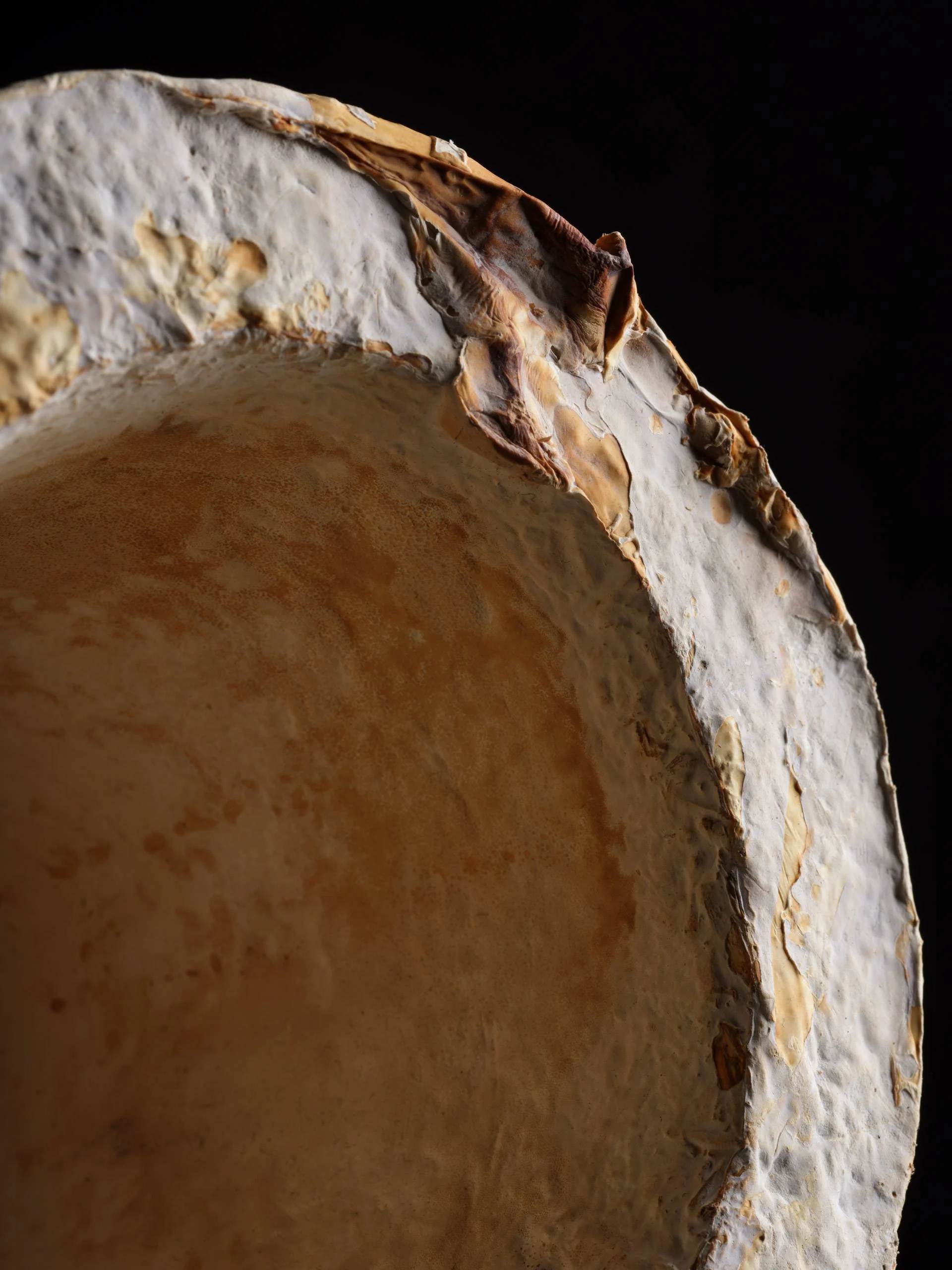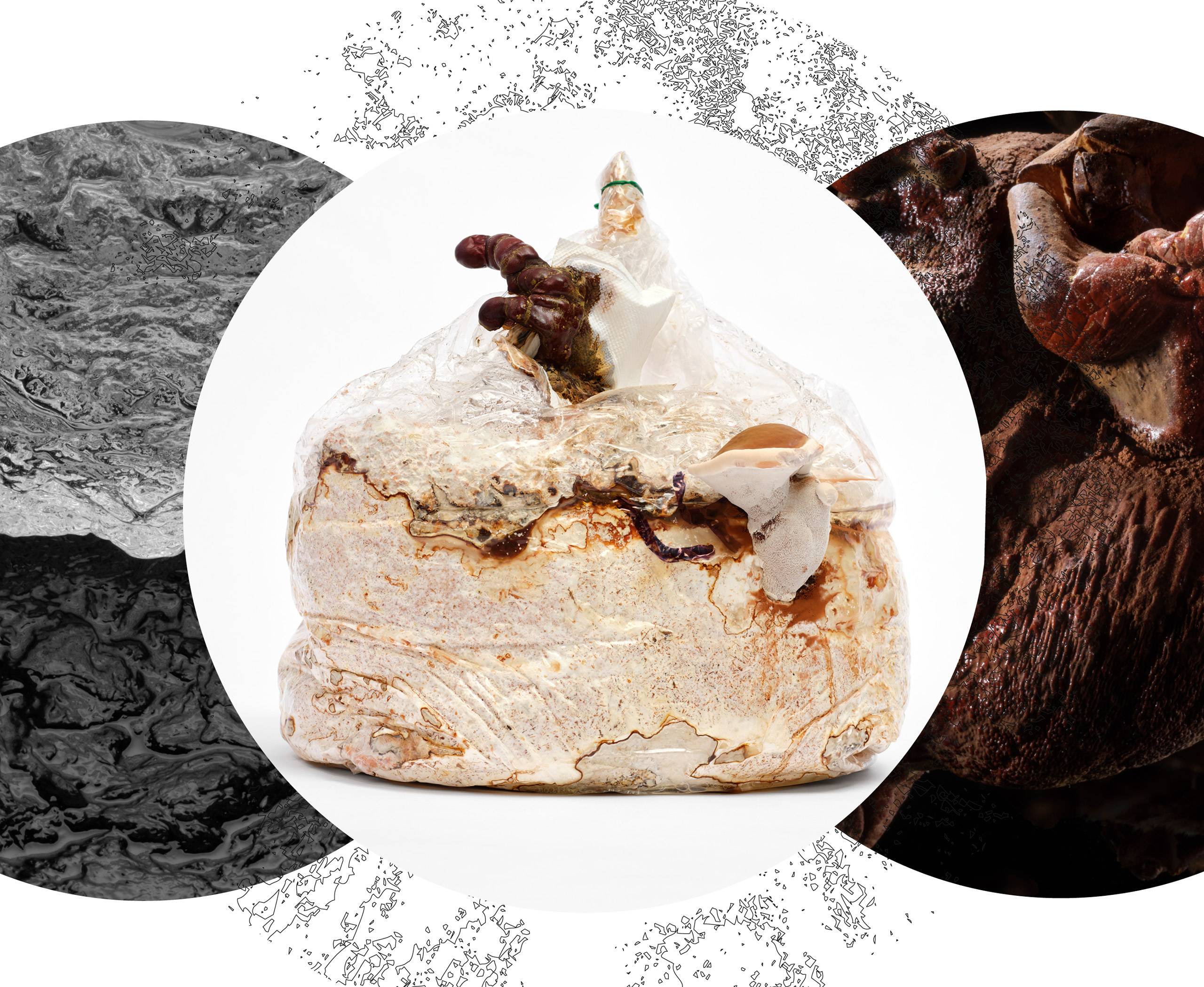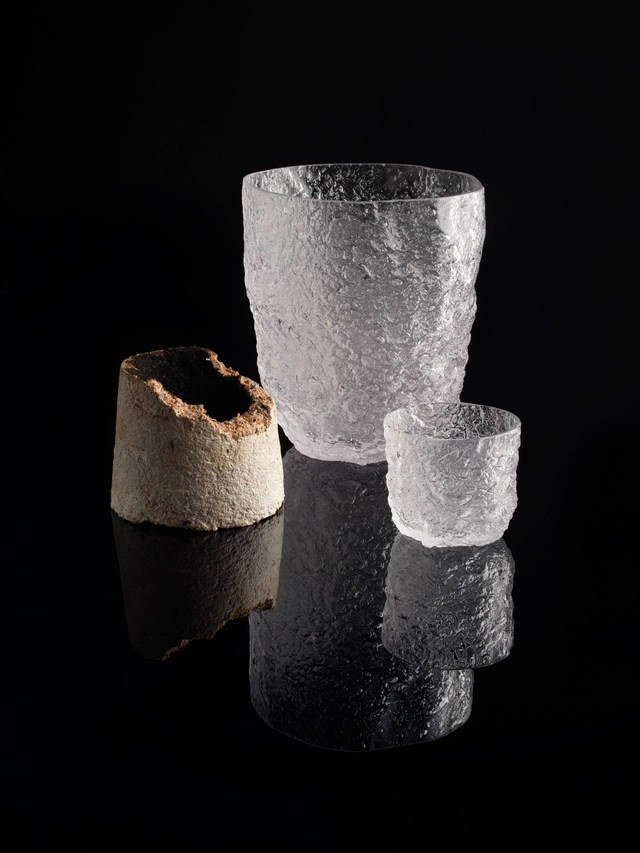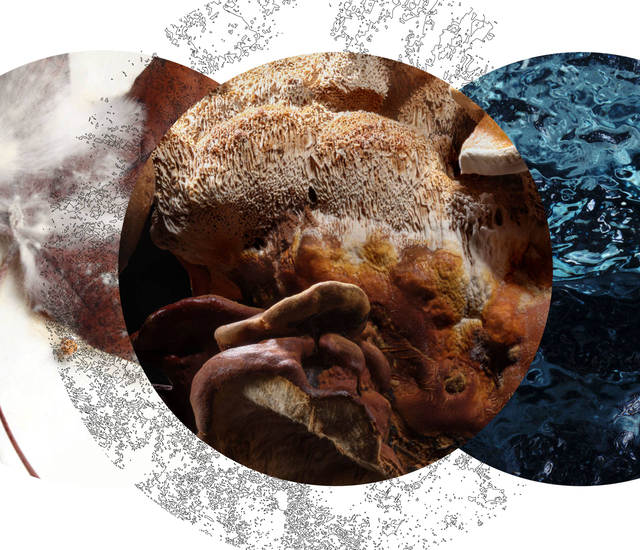The Unexpected Symboll-ism of Fungi
By: Alexandra Anith Střelcová
Photo: JAFR
It took exactly four minutes and thirty-three seconds for John Cage – the American composer and amateur mycologist – to revolutionise the fundamental understanding of music and noise. “Hearing” his 1952 piece, the aptly named 4’33, that requires performers not to play their instruments, the amazed audiences realised there is no such thing as silence. A whole new world opens up when listening to sounds we never thought were part of the story.

The mould is made of mycelium and beech sawdust, a by-product of glass mould production. As mycelium grows, it forms a thicker leather-like skin on the surface, transforming wood waste into a thriving ecosystem that can once again be put to use. The brown spots indicate where the fruiting bodies will soon grow, although they aren’t used in the final mould.
Cage’s passion for neglected sounds can very well illustrate humans’ perception of fungi. Considered part of the plantae kingdom until a few decades ago, the contribution of fungi to the ecosystems of this planet long went unnoticed. But if humans weren’t able to survive without oxygen produced by plants, plants wouldn’t be able to survive without mycelium, the extent and role of which is sometimes referred to as the wood wide web. Thanks to mycelium – the subterranean network of fungi branches – plants can communicate, distribute nutrients or send each other signals when in danger.
Much of human life as we know it has been impacted by fungi. They are literally everywhere: from alcohol over sour dough to a mould producing a bacteria-killing substance known as penicillin. Fungi can break down rock, crude oil, plastics or TNT. They can push their way through asphalt, although they themselves weigh no more than a few grams. Their populations thrive in places no sane human would ever venture into, for instance the immediate surroundings of the Chernobyl nuclear power plant.

Quite tellingly, the collection is named Symboll, encouraging the audience to discover the glassware production process in previously unthinkable ways. This particular one uses moulds that were made of mycelium and wood waste, striving to represent a symbol of change.
A recent surge in fungi popularity spearheaded by the likes of Merlin Sheldrake or Paul Stamets has sparked a growing interest in the topic, especially with designers, artists, and entrepreneurs. Brands like Mercedes, Hermès or Adidas have incorporated mycelium in their products. Its potential in rocket science is studied by NASA. Innovative approaches to mycelium as a material have been literally springing up like mushrooms: sustainable packaging, ethical leather, building material, and even coffins. All effortlessly comply with the current standards for the natural, circular, or biodegradable.

The uniqueness of Symboll lies in its distinctive shape formed by mycelium growth processes. Furthermore, it marks the first time this material was used in glass mould production.
Czechs are often labelled as a nation of avid wild mushroom pickers, yet working with mycelium hasn’t quite taken off in the local design community so far. But this year, he aforementioned experimentation with the material has resulted in a collaboration between Lasvit and LLEV design studio who are no newbies in the field. Together, they launched Symboll, a glassware collection shaped by natural processes characteristic of mycelium growth. Not only is this the first time the material is used in crafting moulds for glassmaking, it aspires to revolutionise glass production with a method using beech sawdust as the basis for growing mycelium.

Plants and fungi collaborate through a subterranean network sometimes nicknamed the wood wide web. This mutual relationship continues even as the mycelial filaments, hyphae, gradually absorb the dead plant leaf structure, until eventually breaking it down.
“Our family conversations inspired us to start experimenting with mycelium as a material for use it in design. As a result of these discussions, we ordered a bag of spores from the Netherlands at the end of 2019,” says Eva Mochalová who set up LLEV design studio together with her partner Marcel in 2004. Based in a remote village near Turnov in northern Bohemia, they spent the first months of Covid lockdowns testing and processing the material, and then presented a collection of candlesticks and tables at Designblok 2020. “But we didn’t want to stop at making furniture, bowls or pots, a lot of colleagues abroad are doing that. We asked ourselves: How can we take this passion to another level?”
One particular detail immediately caught their attention: among other qualities, mycelium is fire-retardant. As Head of Studio of Glass at the Faculty of Art and Design in Ústí nad Labem, Marcel has seen glass being blown into all sorts of materials including a pumpkin or cardboard. “We thought, why couldn’t we try blowing glass into moulds made of mycelium? After all, unlike other types of moulds, they can be taken to the woods or compost,” adds Eva.

The process of blowing glass into moulds made from beech sawdust impregnated with mycelium remains largely experimental. But the material is already being hailed for its fire-retardant properties thanks to which the mould can withstand the heat. And as a plus, it is fully biodegradable.
In order to achieve this, LLEV teamed up with Brno-based start-up Mykilio who grew the forms using Ganoderma lucidum, a mushroom also used for medicinal purposes. “Mushrooms have been cultivated artificially for food and gastronomy for at least fifty years,” says Matěj Róth who co-founded Mykilio with Jakub Seifert in 2019. “We use grain inoculum combined with ligno-celulous wastes like sawdust, straw, or coffee grounds. All the input materials imprint their mechanical properties into the final product and the mushroom basically acts as a glue that binds all the different parts together,” he explains the background of the process.

A fully colonised substrate by Ganoderma lucidum with a young fruiting body on the top. Sometimes called reishi, the mushroom is also used in traditional Chinese and Japanese medicine to fight fatigue, stimulate the immune system, or to treat respiratory tract infections.
After the fungus finally rips through the substrate, it is ground into a powder and poured into negative moulds. It takes three to seven days before the resulting object can be taken out and dried at about 80 degrees Celsius to kill the remaining fungus in order to prevent its further growth. Glass is then blown into the moulds, with mycelium leaving a unique imprint on each piece in a slightly different way.

The collection Symboll by LLEV design studio is a result of cooperation between humans and nature, with the latter being the creator itself. Mycelium’s natural growth always leaves a unique imprint on the surface of each product.
“We are not the designers of this set, rather we let nature create. We’ve just nudged it and given it some direction, but we’re letting it work on its own. With glass — the creation of which is also a natural process — the two things come together to produce this unique shape,” says Eva whose passion for mycelium can be an inspiration to others on their journey of discovering what’s underneath our feet. “If we understand fungi, listen to and cooperate with them, and live together in symbiosis, everyone will benefit.”



